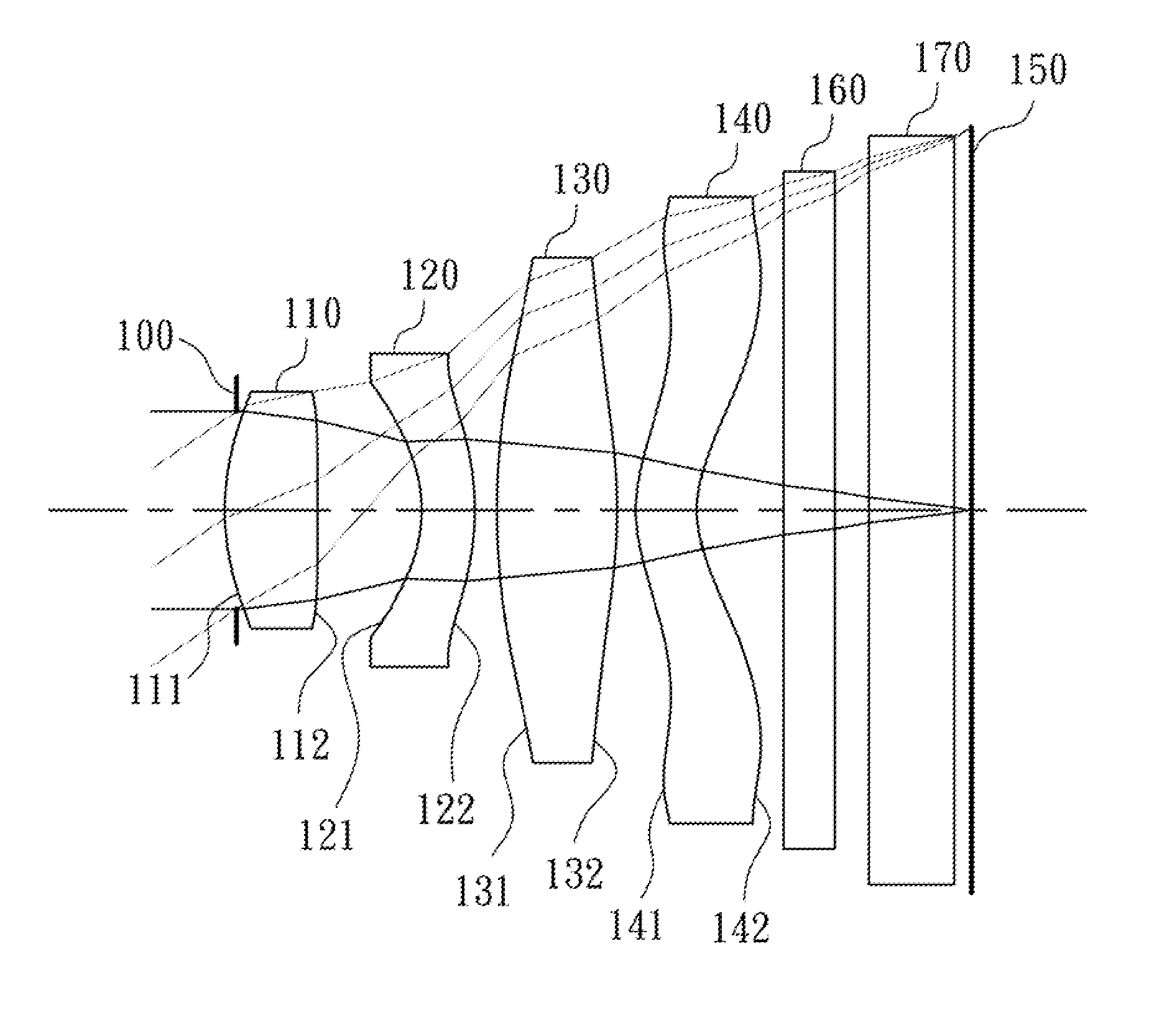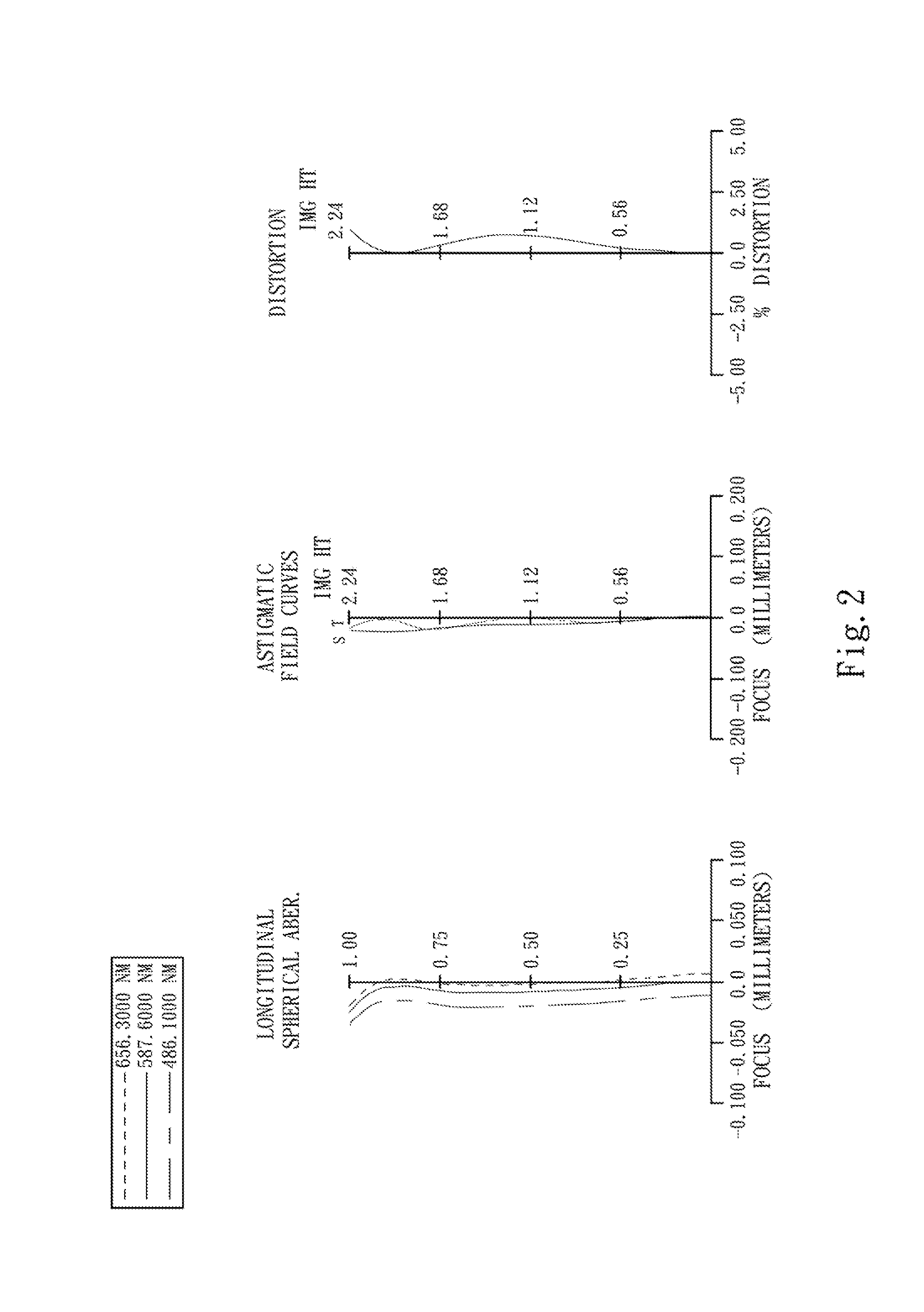Photographing optical lens assembly
a technology of optical lens and assembly, applied in the field of can solve the problems of reducing the sensitivity of the total track length and reducing the sensitivity of the photographing optical lens assembly, and the structure requires a longer total optical track length
- Summary
- Abstract
- Description
- Claims
- Application Information
AI Technical Summary
Benefits of technology
Problems solved by technology
Method used
Image
Examples
first embodiment
[0059]The equation of the aspheric surface profiles of the above lens elements of the first embodiment is expressed as follows:
X(Y)=(Y2 / R) / (1+sqrt(1-(1+k)×(Y / R)2))+∑i(Ai)×(Y′)
[0060]wherein:
[0061]X: the height of a point on the aspheric surface spaced at a distance Y from the optical axis relative to the tangential plane at the aspheric surface vertex;
[0062]Y: the distance from the point on the curve of the aspheric surface to the optical axis;
[0063]k: the conic coefficient; and
[0064]Ai: the i-th order of the aspheric coefficient.
[0065]In the photographing optical lens assembly according to the first embodiment, f is a focal length of the photographing optical lens assembly, and Fno is an f-number of the photographing optical lens assembly, HFOV is half of the maximal field of view, and they satisfy the following relationships:
f=3.30 mm;
Fno=2.85; and
HFOV=34.0 degrees.
[0066]In the photographing optical lens assembly according to the first embodiment, V1 is an Abbe number of the first ...
second embodiment
[0084]The detailed optical data of the second embodiment is shown in Table 3, and the aspheric surface data is shown in Table 4 as follows.
TABLE 32nd Embodimentf = 3.06 mm, Fno = 3.00, HFOV = 36.2 deg.Surface #Curvature RadiusThicknessMaterialIndexAbbe #Focal length0ObjectPlanoInfinity1Lens 11.52036(ASP)0.403Plastic1.54455.93.02218.49445(ASP)0.0703Ape. StopPlano0.5274Lens 2−0.91258(ASP)0.304Plastic1.65021.4−3.125−1.87836(ASP)0.1406Lens 33.75963(ASP)0.779Plastic1.54455.92.677−2.20078(ASP)0.1408Lens 41.04246(ASP)0.381Plastic1.54455.9−7.3890.72098(ASP)0.57610IR-filterPlano0.300Glass1.51764.2—11Plano0.53512ImagePlano—The reference wavelength (d-line) is 587.6 nm.
TABLE 4Aspheric CoefficientsSurface #1245k =−9.91985E−01−1.91165E+02−4.65146E+008.32243E−01A4 =−1.88085E−02−1.19501E−01−8.51909E−01−2.01375E−01A6 =−8.23236E−02−1.06954E−012.05618E+008.70795E−01A8 =8.47925E−01−5.59555E−01−3.86874E+00−1.39770E+00A10 =−4.77462E+008.35023E−015.35721E+001.84547E+00A12 =5.53972E+00−1.07213E+00−6.16945...
third embodiment
[0094]The detailed optical data of the third embodiment is shown in Table 5, and the aspheric surface data is shown in Table 6 as follows.
TABLE 53rd Embodimentf = 3.08 mm, Fno = 2.85, HFOV = 36.0 deg.Surface #Curvature RadiusThicknessMaterialIndexAbbe #Focal length0ObjectPlanoInfinity1Ape. StopPlano−0.0282Lens 11.58545(ASP)0.501Plastic1.53055.82.783−18.41620(ASP)0.5734Lens 2−0.89091(ASP)0.309Plastic1.63223.4−2.685−2.13532(ASP)0.1006Lens 34.31040(ASP)0.674Plastic1.53055.83.127−2.53232(ASP)0.1768Lens 40.94954(ASP)0.394Plastic1.53055.8−18.5690.74150(ASP)0.55010IR-filterPlano0.300Glass1.51764.2—11Plano0.13012Cover-glassPlano0.400Glass1.51764.2—13Plano0.12214ImagePlano—The reference wavelength (d-line) is 587.6 nm.
TABLE 6Aspheric CoefficientsSurface #2345k =−9.61820E−010.00000E+00−4.47015E+000.00000E+00A4 =−1.35894E−02−1.64202E−01−8.90354E−01−3.02958E−01A6 =−2.50349E−01−1.38641E−011.88836E+009.17413E−01A8 =9.93674E−01−3.65356E−01−3.61231E+00−1.37783E+00A10 =−3.39050E+007.58137E−015.85314...
PUM
 Login to View More
Login to View More Abstract
Description
Claims
Application Information
 Login to View More
Login to View More - R&D
- Intellectual Property
- Life Sciences
- Materials
- Tech Scout
- Unparalleled Data Quality
- Higher Quality Content
- 60% Fewer Hallucinations
Browse by: Latest US Patents, China's latest patents, Technical Efficacy Thesaurus, Application Domain, Technology Topic, Popular Technical Reports.
© 2025 PatSnap. All rights reserved.Legal|Privacy policy|Modern Slavery Act Transparency Statement|Sitemap|About US| Contact US: help@patsnap.com



